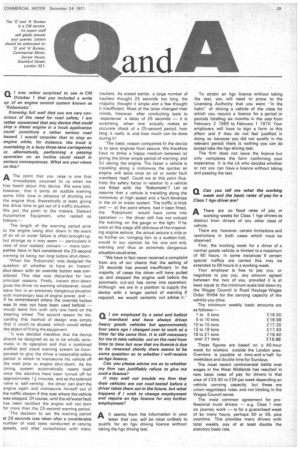0 I was rather surprised to see in CM
Page 31

If you've noticed an error in this article please click here to report it so we can fix it.
• October 1 that you included a write up of an engine control system known as "Robomatic".
Knowing full well that you are very conscious of the need for road safety, I am rather concerned that any device that could stop a diesel engine in a truck application could constitute a rather serious road hazard. I would consider that to stop an engine while, for instance, the truck is overtaking in a busy three-lane carriageway or, alternatively, performing a passing operation on an incline could result in serious consequences. What are your views on this?
AThe point that you raise is one that immediately occurred to us when we first heard about this device. We were told, however, that it emits an audible warning some little time in advance of shutting out the engine thus, theoretically at least, giving the driver time to get out of a traffic situation. We put the point to the makers, Stewart Automotive Equipment, who replied as follows:—
The length of the warning period prior to the engine being shut down in the event of an oil or water failure is often brought up. but strange as it may seem — particularly in view of your readers' concern — many companies have in fact considered the 25-second warning as being too long before shut-down.
When the 'Robomatic' was designed the question of whether to have an 'instant' shut-down with an override button was considered. This idea was discarded for two principal reasons. Firstly, instant shut-down gives the driver no warning whatsoever, could leave him in an extremely dangerous situation with momentary loss of engine power. and -if he remembered where the override button was it may not have been used before) -would leave him with only one hand on the steering wheel_ The second reason for discarding this method of design was simply that it could be abused. which would defeat the object of fitting the equipment.
'It was decided therefore that the device should be designed so as to be wholly automatic in its operation and that a combined audible and visual warning system be incorporated to give the driver a reasonable safety period in which to manoeuvre his vehicle off the road prior to engine shut-down. As the timing system automatically resets itself once the electrics have been turned off for approximately 14minutes. and as the solenoid valve is 'self-venting', the driver can start the engine again and manoeuvre himself out of the traffic stream if this was where the vehicle was stopped. Of course, until the oil/water fault has been rectified the engine will not start for more than the 25-second warning period.
-The decision to set the warning period at 25 seconds was taken after a considerable number of road tests conducted at varying speeds, and after' consultation with many
hauliers. As stated earlier, a large number of hauliers thought 25 seconds too long, the majority thought it ample and a few thought it insufficient. Most of the latter changed their minds, however, after conducting tests to experience' a delay of 25 seconds — it is surprising, when one actually makes an accurate check of a 25-second period, how long it really is and how much can be done during it I
'The basic reason companies fit the device is to save engines from seizure. We therefore have to strike a happy medium between (a) giving the driver ample period of warning. and (b) saving the engine. The faster a vehicle is travelling along a motorway the quicker an engine will seize once an oil or water fault manifests itself. Could we at this point illustrate the safety factor in relation to a vehicle not fitted with the 'Robomatic'? Let us assume that a vehicle is travelling along the motorway at high speed and a fault develops in the oil or water system. The traffic is thick and — at the point where, had it been fitted, the Robomatic' would have come into operation — the driver still has not noticed the warning on the gauge or the light If he were at this stage still oblivious of the impending engine seizure, the actual seizure a mile or so further on, bringing him to a sudden halt, would in our opinion be his one and only warning and thus an extremely dangerous situation could arise.
"We have in fact never received a complaint from any of our clients that the setting of 25 seconds has proved insufficient. In the majority of cases the driver will have pulled up and stopped the engine well before the automatic cut-out has come into operation. Although we are in a position to supply the device with a longer period of warning if required, we would certainly not advise it."




































































